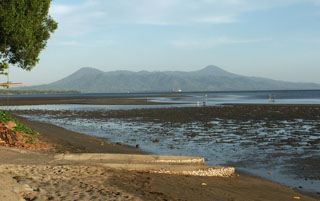Report on Krummel-Garbuna-Welcker (Papua New Guinea) — October 2008
Bulletin of the Global Volcanism Network, vol. 33, no. 10 (October 2008)
Managing Editor: Richard Wunderman.
Krummel-Garbuna-Welcker (Papua New Guinea) Occasional ash and steam emissions July to October 2008
Please cite this report as:
Global Volcanism Program, 2008. Report on Krummel-Garbuna-Welcker (Papua New Guinea) (Wunderman, R., ed.). Bulletin of the Global Volcanism Network, 33:10. Smithsonian Institution. https://doi.org/10.5479/si.GVP.BGVN200810-252070
Krummel-Garbuna-Welcker
Papua New Guinea
5.416°S, 150.027°E; summit elev. 564 m
All times are local (unless otherwise noted)
Weak to moderate seismicity with an ash emission occurred during March 2008 (BGVN 33:02). According to the Rabaul Volcano Observatory (RVO), white vapor rose from Garbuna during the first 12 days of July; however on 13 July, moderate-to-strong emissions of pale-white to light-gray ash clouds were observed. The ash emissions formed a column that rose ~ 1 km above the summit area. Seismic activity was generally very low during the period.
Additional ash emissions occurred on 5 August, accompanied by incandescent lava ejection, and between 23 September and 1 October. Ash plumes rose ~ 1.6 km and drifted NW. During 1-4 October, forceful emissions of dense white plumes from Garbuna were accompanied by intermittent ash emissions that rose to an altitude of 1.6 km. RVO reported that occasional weak roaring and rumbling noises were heard in Garu village, about 9 km NW.
An overflight on 3 October revealed that existing vents at the summit had increased in size and new vents and fumaroles had appeared in the E sector of the lava dome. The main vent, which had been located on the cone's outside flank, had enlarged considerably (more than tripled in size) and had merged with the November 2005 vent. The original vent that opened on 17 October 2005 was larger and vigorously fuming. There was little evidence of juvenile material having been ejected and surprisingly little eruptive material around the summit; however areas more than 1 km away from the active vents were cratered, possibly from lithic bombs. Fumarolic activity in the summit region away from the currently active vents had ceased.
On 6-10 October the RVO reported that white plumes from Garbuna were emitted and deep booming noises were occasionally heard. On 7 October, an explosion produced forceful emissions of dense white vapor. Seismicity increased to a high level after the explosion. It was characterized by continuous overlapping tremors that continued for a while before declining to a low level again. RVO recorded low-frequency earthquakes on 6 and 8 October. No volcano-tectonic (high-frequency) earthquakes were recorded with those events.
Geological Summary. The basaltic-to-dacitic Krummel-Garbuna-Welcker Volcanic Complex consists of three volcanic peaks located along a 7-km N-S line above a shield-like foundation at the southern end of the Willaumez Peninsula. The central and lower peaks of the centrally located Garbuna contain a large vegetation-free area that is probably the most extensive thermal field in Papua New Guinea. A prominent lava dome and blocky lava flow in the center of thermal area have resisted destruction by thermal activity, and may be of Holocene age. Krummel volcano at the south end of the group contains a summit crater, breached to the NW. The highest peak of the group is Welcker volcano, which has fed blocky lava flows that extend to the eastern coast of the peninsula. The last major eruption from both it and Garbuna volcanoes took place about 1800 years ago. The first historical eruption took place at Garbuna in October 2005.
Information Contacts: Herman Patia, Steve Saunders, and Ima Itakarai, Rabaul Volcano Observatory (RVO), PO Box 386, Rabaul, Papua New Guinea.

